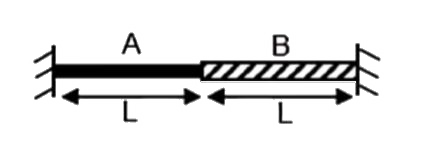Two different wire A and B of same cross sectional area are joined to form a composite wire of length 1.5m of which wire A is 0.6 m and the rest is wire B. The densities of A and B are in the ratio 1:4 when the joint in the wire is a node , then the number of loops formed in A and B are in the ratio
2:3
3:2
1:2
1:3
The correct Answer is:D
l1=0.6,l2=0.9,ρ1ρ2=14,P1P2=?
n1=n2
P1l1√Tρ1=P2l2√Tρ2
P1P2=l1l2√ρ1ρ2
=0.60.9×√14=23×12=13
Topper's Solved these Questions
Similar Questions
An aluminium wire of length 0.6 m and cross-sectional area 10−6m2 is connected to a steel wire of the same crosssectional area and length 0.866 m. The compound wire is loaded with 10 kg. Find the lowest frequency of excitation for which the joint in the wire is a node. Also find the number ofnodes, excluding the two at the ends of the wire. The density of aluminium is 2600kg/m3 andthatofsteel is 7800kg/m3
View SolutionA composite wire of length 2L is made by joining two different wires A and B having the same length, made of the same material but of different radii r and 2r respectively . The composite wire is vibrating at such a frequency, that the junction of the two wires form a node. If the number of antinodes in the wire A is p and that in the wire B is q, then the ratio p:q is

View Solution
Knowledge Check
Two wires A and B have the same cross section and are made of the same material, but the length of wire A is twice that of B. Then, for a given load
Athe extension of A will be twice that of BBthe extensions of A and B will be equalCthe strain in A will be half that in BDthe strains in A and B will be equalTwo wires of different materials each of length l and cross sectional area 'A' are joined in series to form a composite wire. If their young's moduli are Y and 2Y, the total elongation produced by applying a force F to stretch the composite wire will be
A3FA2YlB2FA3YlC2FA3AYD3Fl2AYTwo wires of the same material and same cross sectional area are vibrating with the same frequency. The first wire of length 80 cm is loaded with 8 kg and the second wire is loaded with 2 kg. The length of the second wire is
A40cmB80cmC70cmD60cm
Two wires A and B are of the same material. Their lengths are in the ratio 1 : 2 and the diameter are in the ratio 2 : 1. If they are pulled by the same force, then increase in length will be in the ratio
View SolutionTwo wire of the same material and length stretched by the same force. If the ratio of the radii of the two wires is n : 1 then the ratio of their elongations is
View SolutionTwo uniform wires A and B of same metal and have equal masses, the radius of wire A is twice that of wire B. The total resistance of A and B when connected in parallel is
View SolutionA copper wire and a steel wire of the same length and same cross-section are joined end to end to form a composite wire. The composite wire is hung form a rigid support and a load is suspended form the other end. If the increses in length of the composite wire is 2.4mm. then the increases in lenghts of steel and copper wires are
View SolutionOne end of wires of the same metal and of same length (with radius, r and 2r) are joined together. The wire is used as sonometer wire and the junction is placed in between two bridges. The tension T is applied to the wire. If at a junction a node is formed then the ratio of number of loops formed in the wires will be:
View Solution
